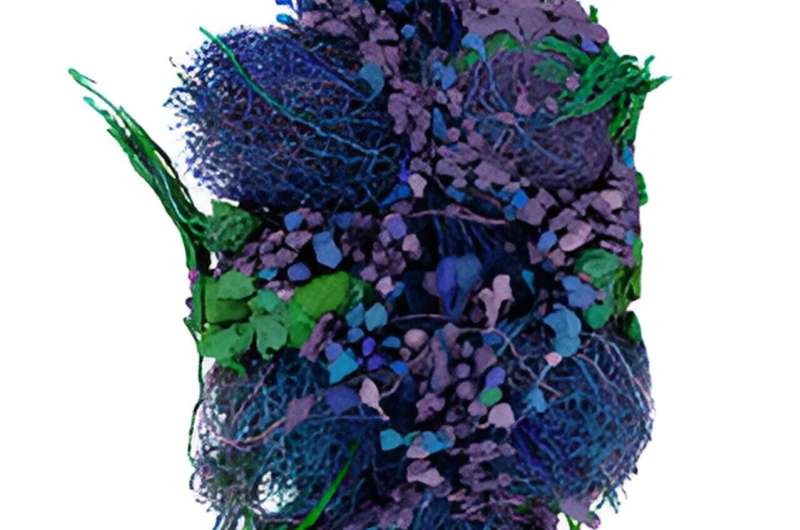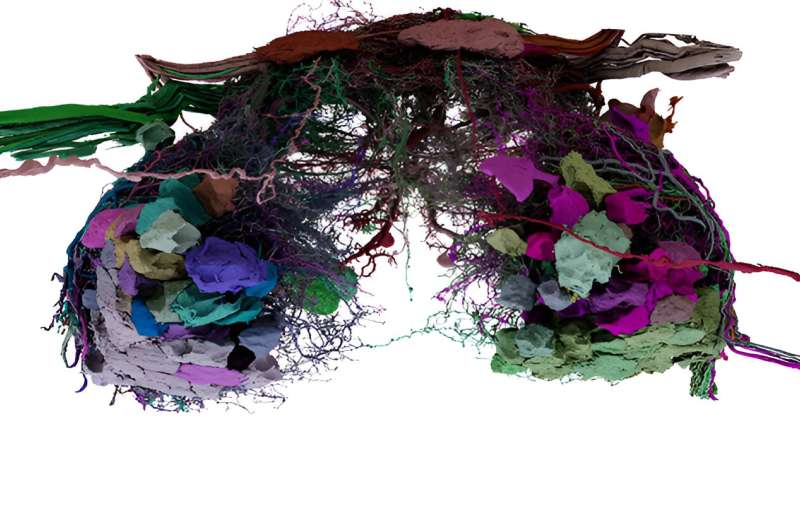This article has been reviewed according to Science X's editorial process and policies. Editors have highlighted the following attributes while ensuring the content's credibility:
fact-checked
peer-reviewed publication
trusted source
proofread
From takeoff to flight, the wiring of a fly's nervous system is mapped

Work is underway on a wiring diagram of the motor circuits in the central nervous system that control muscles in fruit flies. This connectome, as the wiring diagram is called, is already providing detailed information on how the nerve coordination of leg movements differs from that controlling the wings.
Although fruit flies seem like simple creatures, the researchers said that their motor system contains "an unexpected level of complexity."
"A typical fly motor neuron receives thousands of synapses from hundreds of presynaptic premotor neurons," the scientists observed. "This number is on par with the scale of synaptic integration in pyramidal cells of the rodent cortex."
Some of the latest findings in this area are published in two papers on June 26 in the scientific journal Nature. They are titled "Synaptic architecture of leg and wing premotor control networks in Drosophila" and "Connectomic reconstruction of a female Drosophila ventral nerve cord."
The senior scientists jointly supervising the research were John C. Tuthill, associate professor of physiology and biophysics at the University of Washington School of Medicine in Seattle, and Wei-Chung Allen Lee, associate professor of neurology at Harvard Medical School in Boston. A multi-institutional group of scientists contributed to the studies.
This research advances the understanding of how the central nervous system in animals coordinates individual muscles to carry out a variety of behaviors. A fruit fly uses its legs, for example, in leaping, walking, grooming, fighting and courtship. It can also adapt its gait to navigate terrains like house plants, walls, damp surfaces, ceilings—and even insect-scale treadmills.
All such movements, from postural reflexes that enable a fly to hold its position steady, to traversing obstacles or changing flight direction, originate through electrical signals from motor neurons. These signals are conducted through threadlike projections from the motor neuron to stimulate muscles.
A fly's six legs are managed by just 60 to 70 motor neurons, the researchers pointed out. In a cat, they noted, about 600 motor neurons supply a single feline calf muscle. Only 29 motor neurons govern the power and steering muscles of a fruit fly wing. In comparison, a hummingbird's pectoral muscle is supplied by 2,000 motor neurons.
Although the fly's motor neurons are few, it performs remarkable aerial and terrestrial feats.
The scientists explained that motor units are composed of a single motor neuron and the muscle fibers that it can excite. Various motor units, activated in different combinations and sequences, collaborate to achieve a myriad of movement behaviors.
The scientists in the two studies were interested in the wiring logic of premotor circuits. They wanted to understand how a fly's nervous system coordinates motor units to accomplish varied tasks.
One of the studies employed automated tools, machine learning, cell-type annotation, and electron microscopy to identify 14,600 neuronal cell bodies and about 45 million synapses (signal-transmission junctions) in the ventral nerve cord of a female fruit fly. The ventral nerve cord in flies is analogous to the spinal cord in vertebrates. They scientists went on to apply deep learning to automatically reconstruct the anatomy of the neurons and their connections throughout the female fly.

Then the researchers used sophisticated methods to map the muscles targeted by leg and wing motor neurons. They determined which motor neurons in the female adult nerve cord connectome connect to individual muscles in the front leg and wing. From there, they created an atlas of the circuits that coordinate the fly's leg and wing movements during take-off and flight motor initiation.
To get into the air, the fly's middle legs extend to jump and its front legs flex for departure. This is very roughly like a taxiing airliner retracting its wheels after leaving the ground or a wading heron tucking its spindly legs to keep them out of the way as it rushes into the sky.
As part of their work, the scientists also found that some muscle fibers in adult flies are innervated by several motor neurons. This also occurs in the larval stage of the fruit fly and in locusts. While some mammals have multiple innervations of nerve fibers as newborns, these usually disappear by adulthood.
Multiple innervations might offer more flexibility and explain why an insect's limbs can operate with precision despite having so few motor neurons.
The scientists also examined the fly's wing motor system, which has roughly three sections grouped by function: powering the wing flapping, steering the insect, and adjusting wing motion.
The investigation of the connectivity of the premotor neurons enabled the researchers to compare the organization of premotor circuits for two types of limbs. The leg and the wing in fruit flies each have a distinct evolution and biomechanics.
More generally, connectomes are allowing scientists to produce new theories on how neural circuits function, and to debunk some false notions. The scientists mentioned that the recent community effort to develop the fruit fly connectome has led to one of the first synapse-level wiring diagrams for any limbed animal. They hope that additional connectomes will allow researchers to compare neural wiring across individuals. The anticipated reconstruction of a male fruit fly's central nerve cord might illuminate differences between sexes.
More information: John Tuthill, Synaptic architecture of leg and wing premotor control networks in Drosophila, Nature (2024). DOI: 10.1038/s41586-024-07600-z. www.nature.com/articles/s41586-024-07600-z
Anthony Azevedo et al, Connectomic reconstruction of a female Drosophila ventral nerve cord, Nature (2024). DOI: 10.1038/s41586-024-07389-x
Journal information: Nature
Provided by University of Washington School of Medicine





















